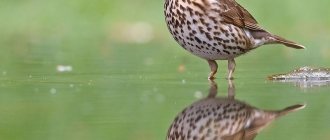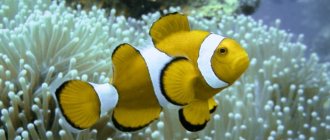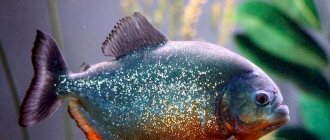09/22/2020 Scientist cat Animals Piranhas are monsters from horror films and scary stories, small but bloodthirsty inhabitants of the waters of the Amazon and other rivers in South America (Colombia, Venezuela, Paraguay, Brazil, Argentina). What do we know about them? Probably nothing. After all, all knowledge is limited to just one species - the common piranha, which has gained notoriety.
What does piranha fish look like?
The Piranha family includes slightly more than 60 species of fish. And, oddly enough, most of them are herbivores; they practically do not eat animal food. The size of piranhas depends on the species, carnivores generally reach 30 cm, and their vegetarian relatives can gain significant weight and grow more than one meter in length. The color also depends on the species, but is mainly silver-gray, becoming darker with age. The body shape is diamond-shaped and tall, laterally compressed. The main food for predators is a variety of freshwater fish; piranhas can also feed on animals or even birds that they meet along the way. For herbivorous species, the Amazon and its tributaries abound in various vegetation; these fish do not disdain nuts and seeds that fall into the water.
Compatibility with other fish
Piranhas are aggressive and therefore not suitable for keeping in a community aquarium, although they can easily get along with other representatives of their kind. You can only check the admissibility of such a neighborhood in each individual case in practice, constantly monitoring your pets.
Even if everything is fine for some time, there is always a risk of sudden outbursts of aggression and manifestations of cannibalistic tendencies. This often occurs when a dominant (the most aggressive and largest) and a less powerful fish collide in a fight for food or territory.
The only exception to the general rule is catfish belonging to the genus Hoplosternum; they help piranhas get rid of parasites, and therefore are not attacked by these parties.
In conditions close to natural, piranhas address their relatives using special sounds that occur when the swim bladder vibrates. If they decide to scare off the enemy with their “speech,” the signals will be coughing or barking, and during a direct attack the predator begins to “croak.”
We recommend reading
Japanese koi carp
Jaw structure
Piranhas are characterized by an amazing structure of the jaw apparatus, which perhaps has no analogues in nature. Everything is provided in it down to the finest detail. The teeth, triangular in shape and measuring 4-5 mm, are lamellar and sharp, like a razor blade, slightly curved inward. This allows them to easily cut through the flesh of the victim, tearing off pieces of meat. In addition, the upper and lower teeth fit perfectly into the sinuses when the jaw is closed, creating a strong pressure. This feature allows piranhas to bite through bones. When closed, the jaws close like a trap. According to the latest research by scientists, the bite force is 320 newtons and has no analogues in the animal world. When a piranha's jaws bite, it exerts about 30 times its weight in pressure.
Aquarium piranhas, names and photos
Metinnis and milei are quite often bred in aquariums - quite peaceful fish from the piranha family. In nature, they feed on aquatic plants, fruits, and small mollusks. Metinnis have a body length of about 15 cm and are silver in color. Species differ in shades of colors and the presence of spots.
- Metynnis silver (silver dollar fish) (lat. Metynnis argenteus)
This is a relatively small fish, which has a body length of 10 to 14 cm. The color of metinnis is silver-gray, dark warts are scattered over the body. The anal fin of the male is veiled, while that of the female is straight and reddish.
The homeland of the fish is the rivers of the Orinoco and Amazon basins.
Taken from: www.bidorbuy.co.za
- Metynnis spotted (spotted dollar fish) (lat. Metynnis maculatus )
Reaches 12-15 cm in length and has spots on the sides.
The Metinnis fish comes from the Guapore River, which belongs to the Amazon River basin.
Taken from the site: fishmarket.org.ua
- Metynnis vulgaris ( aka Metynnis Schreimuller, mirror fish) (lat. Metynnis hypsauchen )
This is a 15-centimeter fish of silver color, with a white belly and transparent fins. The back of the metinnis can have different shades: grayish-blue, brown or green. The scales have a blue, yellow or greenish tint. The end of the anal fin is red. The body of the fish is high and round, strongly flattened on the sides. There may be black transverse stripes and spots along the sides.
In nature, Metinnis vulgaris lives in the Amazon and Paraguay rivers.
Photo by: Milan Kořinek
- Redfin mileus (stellate mileus) (lat. Myloplus rubripinnis)
Found in the rivers of Guyana, Suriname and the Amazon.
Dimensions are 10-25 cm, in an aquarium it grows up to 15 cm. The fish has a silver-gray body color and a reddish anal fin. There are individuals with a reddish belly and red-gold spots on the body. The anal fin of the male has a long outer braid and a notch.
Photo by: Milan Kořinek
Where do piranhas live?
These are inhabitants of freshwater bodies of water in South America. The Amazon basin contains a fifth of all fresh water; this river is full of a variety of fish. Piranhas live along the entire length of the river and are the subject of many legends and stories of local residents. The river's floodplain occupies vast territories, most of which belong to Brazil, but also to Ecuador, Colombia, Bolivia and Peru. Piranhas also feel great in other rivers; their habitat area on the South American continent is very large.
Recently, this fish has become very popular in home keeping and breeding. A piranha in an aquarium will grow smaller than its natural size and will lose some of its aggressiveness. Surprisingly, with such a threatening appearance, they become timid in confined spaces and often hide in artificial shelters.
All piranha fish are combined into one family and are divided, according to zoological classification, into three subfamilies.
Features and habitat of piranha
You can meet piranha in the waters of South America: in Venezuela, Brazil, Bolivia, Argentina, Colombia, Ecuador. Amazon, Orinoco, Parana are the most popular river places where piranha lives .
In the photo there is a piranha pacu fish
They love fresh warm water, rich in oxygen, calm currents and an abundance of vegetation. Sometimes they can be found in sea water. During this period, females are not capable of spawning. Several species of fish can coexist in the same territory.
Myelin subfamily
Myelins are the largest group; it unites seven genera and 32 species. These are herbivores and absolutely harmless piranhas (photo). Fish eat plant foods. The color is quite varied, depending on the species. The body shape is characteristic, laterally compressed and tall. Juveniles are steel-silver in color, with varying degrees of spotting, which darkens to a chocolate gray color as they grow. Sizes vary from 10 to 20 centimeters. Many representatives of this subfamily are bred in aquariums. They need a large volume of water and sufficient hiding space, as they are quite shy fish. Aquarium piranha from the myelin subfamily will feel good at a water temperature of 23-28 degrees, and the daily diet should include lettuce, cabbage, spinach, peas and other vegetables. Some species even feed on nuts in natural conditions, easily cracking the strong shell with their powerful jaws.
Features of care and maintenance
The container with toothy demons is placed as far as possible from sources of constant noise.
We recommend reading
What types of aquarium fish are there?
Water parameters most suitable for river hyenas:
- t°(temperature): 24-26°C;
- pH (acidity): 6.5;
- dH (hardness): 6.0.
The light in a piranha aquarium should be dim. Shelters should also be placed in the container.
Piranhas can be inhabited either singly or in small flocks (from 4 individuals). In the second case, they behave much more active and interesting. Toothed demons swim in all layers of water and are not careful when eating, so you will need to install powerful filters. A container for one fish should hold at least 150 liters of liquid, and for several pets an even larger aquarium will be required.
It is recommended to create a medium-intensity current in the aquarium, and to select algae very carefully, since they are likely to be eaten. For greater safety, plants are placed around the perimeter of the aquarium and fenced off from the main space with driftwood. Rolled pebbles or sea sand are preferred as soil.
Black pacu is the brightest representative of myelin
The black pacu (or Amazon broadbodied) is the most famous member of the Myelina subfamily. In addition, it is also the largest: its dimensions range from 30 centimeters to one meter or more, although it is not a predator. The color of adult individuals is quite modest, brownish-brown, but the young are silver in color with a large number of spots throughout the body and bright fins. Black pacu meat has good taste and is used by local residents. These are commercial piranhas. Aquarium conditions are also quite suitable for them, but the size of the fish will be slightly smaller than in nature, on average about 30 centimeters, life expectancy - within 10 years or a little more. Keeping this species requires a large aquarium (from 200 liters) and good care.
Breeding piranhas
Breeding piranhas in an aquarium
Breeding piranhas at home is extremely difficult and requires an extremely large breeding aquarium of 200 to 300 liters. For successful spawning, high-quality nutrition and appropriate water parameters are necessary.
Piranhas reach sexual maturity at one and a half years. The place chosen for laying is fiercely defended by the pair.
Piranha photo
The female lays eggs at dawn, the male fertilizes them and remains to guard the clutch. Once the spawning is complete, the male will also begin to attack the female and she should be removed from the spawning tank immediately.
The size of piranha eggs is from 2 to 4 mm. The color ranges from transparent amber to yellow-green. At a time, the female can lay from 500 to 15,000 eggs. The incubation period lasts from 2 to 15 days.
Piranhas are beautiful fish. If you provide them with everything they need: space for swimming, clean water without nitrogen compounds, plenty of shelter, high-quality varied food, then they will reciprocate for a long time. Treat piranhas with respect and their menacing teeth will never pose a threat to you. And having an aquarium with such unique fish will always be one of the topics of conversation among your guests.
And the author of the article is Alexander Isakov
Subfamily Catoprionines
This subfamily is represented by only one species - the flag piranha. The fish are quite harmless and lead a semi-parasitic lifestyle, their main food is the scales of other fish, although the appearance of these aquatic inhabitants is quite ominous, and they are not inferior in severity to their carnivorous counterparts. The shape of the flag piranha is diamond-shaped, flattened on the sides. The color of the scales is gray-green with a silvery sheen. A distinctive feature is the presence of a red spot on the gill covers. The outer rays of the anal and dorsal fin are strongly elongated, and the caudal fin has a black root. The sizes are small, only 10-15 cm.
This fish, similar to the common piranha and being its closest relative, mainly has plant foods (60%) in its diet, and only 40% consists of small fish. But it still needs to be kept separately from other fish, otherwise very small ones will be eaten, and large ones risk being left with damaged fins and partially without scales. As animal food, you can use small shrimp or fish, earthworms, and plant food - spinach leaves, lettuce, nettles and other greens.
How to recognize a piranha: description
The piranha's body is flattened on the sides and has a streamlined (almost disc-shaped) shape. In addition, this fish has other distinctive features:
- large and wide caudal fin;
- adipose fin (located between the caudal and dorsal);
- high forehead;
- bulging eyes;
- massive and protruding (like a bulldog) lower jaw, equipped with powerful muscles;
- thick lips, due to which only the tips of sharp teeth are visible;
- extremely small scales.
In most cases, piranha has an olive-silver color, which darkens with age (however, the bodies of individuals of certain species are colored differently). There is a black stripe near the caudal fin, and golden spots can be seen on the scales. The young animals have a silver body color with dark spots.
The teeth of piranhas are shaped like triangles up to 5 mm high. Their location allows the fish to tear large pieces of meat from their prey. Moreover, toothy demons bite through bones and can easily deprive a person of a finger.
We recommend reading
About neon nannakara
Subfamily Serrasalmina
These are the same ruthless predators; the subfamily is represented by only one genus and 25 species. They all eat animal food: fish, animals, birds. The size of piranhas of the Serrasalmina subfamily can reach up to 80 cm in size, reaching a weight of up to 1 kg. This is a real threat to animals (not to mention fish), which can be several times larger in size, but this does not stop the piranha. The appearance of small predators is truly menacing: the lower jaw protrudes significantly forward and is slightly curved upward, the eyes are bulging, and the body is characterized by a rounded flat shape. In reservoirs they prefer to stay in schools, but when attacking a prey they act independently of each other, so it cannot be said that these are close-knit group fish. Piranhas react to movement in the water, this attracts their attention. When one of them finds a victim, the others immediately flock to the spot. Moreover, there is an opinion among zoologists that piranhas are capable of making sounds, thereby transmitting information to each other. A flock of piranhas can leave an animal with only bones in a few minutes.
The information that they are able to sense blood at a considerable distance from the victim is true. Piranha fish live in the murky waters of the Amazon, and it is natural that they had to adapt to conditions of poor visibility, as a result of which they have a well-developed sense of smell. Piranhas are indeed attracted to blood, this is a signal that a prey has arrived.
In addition, they do not disdain carrion and even their sick or weakened brothers. Only a few species pose a real danger to animals and humans.
Piranha's enemies
This small fish is not able to frighten either individuals larger than it in size, or large predators, which, however, have themselves become their victims. But these fish still have enemies:
- River dolphins. They even hunt a school of piranhas.
- Arapaima. This is a fish of enormous size, it has very strong scales, so it is comparable to a fossil. If a piranha strays from the flock, it will die.
- Caymans. These are very dangerous enemies of piranhas. They regulate the population of this fish. It was noticed that if the number of caimans in the rivers decreased, then its number increased.
In the waters of Europe and Russia, you can increasingly find piranhas. This is not a joke of nature, but the fault of inexperienced aquarists who, having failed to care for the fish, decide to release it into the wild.
Europeans and Russians have nothing to fear, since fish do not live in cold waters ; when winter comes, they will all die. The temperature that is comfortable for their stay is between 24 and 27 degrees.
Piranha is a fish that can easily adapt to new living conditions. She feels great in an aquarium, which is why many people try to breed her. At the same time, do not forget about taste preferences, since the fish is predatory.
It needs to be fed properly ; the diet is dominated by small fish, such as sprat and capelin. Don't forget about safety precautions.
Is this predatory fish edible?
This fish is very voracious.
There are many stories that characterize this feature. For example, there is a known case with a pig that fell into the water, when the flock gnawed it to the bone in a matter of minutes. Often the victims themselves are fishermen who want to feast on piranhas. They are caught because the fish's meat is edible , reminiscent of perch. They are often consumed fried. Fishing takes place with a fishing rod, but the fisherman must be very careful, since the fish can snatch off his finger.
So, we can conclude that piranha is an animal necessary for the favorable ecological state of nature, the destruction of which will lead to an imbalance when there is a high chance of outbreaks of epidemics and infections in water bodies.
Common piranha
The most famous representative, around which conversations do not cease, is the Common Piranha. The length of individuals of this species can reach up to 30 centimeters, but they are generally the size of a human palm. Common piranhas (photo of the fish below) have a greenish-silver color with many dark spots throughout the body; the scales on the abdomen have a characteristic pinkish tint. They live in flocks of approximately one hundred individuals.
In recent years, ordinary piranhas have also been very popular in home keeping. Aquarium conditions help reduce aggressiveness. But you still need a separate aquarium.
Types of piranhas, names and photos
Below is a description of some species from the piranha family:
- Common piranha (Natterer's piranha) (lat. Pygocentrus nattereri ) is very dangerous for humans. In its habitat it is called “saikanga”. One of the names was given to the fish in honor of the Austrian scientist Johann Natterer.
The maximum length of the dense disc-shaped body of the fish reaches 60 cm. But usually Natterer’s piranhas have smaller sizes: 25-35 cm. Young individuals are very brightly and beautifully colored. Their body is blue, with a darker back and evenly scattered dark spots. The chest and paired fins are red, the caudal fin is black with a wide blue vertical stripe. The common piranha has this coloration for up to 7-8 months. As they grow older, fish change colors. After the body length exceeds 8 cm, it becomes gray-silver, the sides turn pink, the spots on them fade and disappear, and small golden sparkles appear. The anal fin becomes lighter in color and becomes red with the onset of mating season. Adult piranhas, depending on their mood and condition, are either black with a slight bluish tint and with golden sparkles, or plain black with a red bottom (during the mating season).
The teeth of the common piranha are similar to a saw, with which they can cut pieces of meat from the body of the victim. The lower teeth are larger, the upper teeth are smaller. Females are slightly larger and thicker than males. In addition, they can be distinguished by other characteristics. The keel of the male's abdomen from the front looks like the Latin letter V, and in females it looks like a U. The shape of the anal fin of the male is pointed, while that of the female is rounded.
Common piranhas are found in the rivers of Brazil, Argentina, Colombia, Venezuela, Paraguay, and Guyana.
Photo credit: Tino Strauss, CC BY-SA 3.0
- Red pacu (red-breasted pacu, two-toothed colossoma) (lat. Piaractus brachypomus , syn. Colossoma bidens ) is a herbivorous (herbivorous) species native to Brazil.
The body length of the aquarium fish does not exceed 45 cm, although in nature the pacu grows up to 88 cm. The fish has a bluish-gray body color with silvery scales, a red chest and lower fins. The dorsal fin is elongated, the anal fin is serrated. The edge of the tail has a black frame. Juveniles have dark spots on their sides.
Photo by: Milan Kořinek
- Diamond-shaped piranha (lat. Serrasalmus rhombeus ) got its name from its body shape. Sometimes it is also given the name "black piranha" or "black Brazilian piranha." In addition, this fish is also called the Caribbean red eye - “Caribe ojo rojo”.
It reaches 38 cm in length (according to other sources, 41.5 cm). Most often, the diamond-shaped piranha is colored silver with a greenish or bluish tint, and a stripe runs along the edge of the tail.
The homeland of the fish is Guyana, the Amazon, La Plata.
Photo by: Milan Kořinek
- The slender piranha (lat. Serrasalmus elongatus) has an elongated body measuring no more than 25-30 cm. The color of the fish is silver-gray, the abdomen is reddish, the anal fin is dark, and the tail has a dark border.
The slender piranha lives in the Amazon and Orinoco river basins.
Photo credit: Clinton & Charles Robertson, CC BY 2.0
- The dwarf piranha (lat. S errasalmus hollandi) is named for its small size. Its body length reaches a maximum of 15 cm. But despite this, it is a dangerous predator. The color of the fish is silver with dark spots. The anal fin is red and there is a black border at the end of the tail.
The body and head are elongated. There is a hump at the back of the head.
Photo credit: Felipe Sueti Magalhaes, CC-BY
- Brown pacu (lat. Colossoma macropomum) is a large fish, about 70 cm in length, can reach 108 cm. The body is colored brown, gray and black and their variations. The brown pacu has square teeth, similar to human teeth.
The fish loves solitude: schooling in the brown pacu is less pronounced than in other piranhas.
Photo credit: Tino Strauss, CC BY-SA 3.0
Black piranha
This is another species from the Serrasalmina subfamily, very common in nature and popular in home breeding. Habitat: Amazon and Orinoco rivers. The body shape is diamond-shaped, and the color is dark, black and silver. In young fish, the abdomen has a yellow tint. The black piranha is an omnivorous predator; everything is suitable for its diet: fish, arthropods, birds or animals that accidentally fell into the water. Such indiscriminate eating led to their fairly high numbers in the waters of the Amazon. Although in terms of aggressiveness the species is inferior to the same ordinary piranha. An aquarium for such fish requires a large one, more than 300 liters. The difficulty of breeding lies in the aggressiveness of piranhas towards each other. Reproduction is possible if aquarium members of the family eat properly; if there is an abundance of animal food, they become obese, which can become a significant obstacle to the appearance of offspring. The photo shows a black piranha.
Nutrition of aquarium piranhas
When feeding predatory piranhas use:
- regular live food for aquarium fish;
- meat (poultry, beef, heart);
- fish (swordtails, guppies, goldfish);
- seafood (shrimp, squid meat).
River fish cannot be used for feeding, as it can be a source of infections . It is also not allowed to include large amounts of meat in the menu - this leads to obesity and infertility of piranhas.
The menu of herbivorous fish (metinnis, mileev) includes:
- spinach;
- nettle;
- salad;
- cabbage;
- chopped vegetables (usually cucumbers or zucchini are used).
Sometimes you can offer tubifex or bloodworms to your herbivorous pets, but the total share of these treats in the diet should not exceed 20%.
Myth one: piranhas attack humans
It is difficult to judge this clearly, since the data is very contradictory. Many scientists and zoologists who spent more than one year in the Amazon have never witnessed an attack; in addition, they themselves, exposing themselves to danger for the sake of experiment, swam in the muddy waters of the river, where a few minutes before they had caught piranhas, but there were no attacks followed.
For a long time, there was a story about a bus with local residents that drove into one of the tributaries of the Amazon, and all the passengers were literally eaten by piranhas. The story really took place in the 70s of the last century, 39 passengers died, but one managed to escape. According to eyewitnesses, the bodies of the victims were indeed badly damaged by piranhas. But it is not possible to judge whether this was an attack and whether it was the cause of death.
There are reliable sources of bites on the beaches of Argentina when the fish were the first to attack. But these were isolated cases. Zoologists explain this by the fact that piranhas, whose spawning just begins at the height of the beach season, build nests in shallow water. Therefore, this behavior of fish is quite natural: they protected their offspring.
In addition, piranhas are most dangerous for humans and animals during drought periods, when the water level in rivers reaches its minimum, which affects their diet: there is less food. Local residents know about this and do not enter the river at this time. The safest season is the rainy season, when the rivers overflow.
REPRODUCTION
First of all, the aquarium should be in a quiet place where no one will disturb the fish. Further, the fish must be compatible (a long-established school, with a developed hierarchy). For successful spawning, you need very clean water - a minimum of ammonia and nitrates, pH 6.5-7.5, temperature 28 C, and a large aquarium in which the couple can distinguish their own territory. A pair ready for spawning chooses a spawning site, which it aggressively guards. The piranhas' coloration darkens and they begin to build a nest on the bottom, uprooting plants and moving rocks. Here the female will mark the eggs, which the male will quickly fertilize. After spawning, the male will guard the eggs and attack anyone who approaches it. The eggs are orange in color and will hatch in 2-3 days. The larva will feed from the yolk sac for another couple of days, after which it will swim. From this moment the fry is placed in a nursery aquarium. Be careful, the male can even attack an object while protecting the fry. Already as a fry, piranhas are very greedy for food. You need to feed them Artemia naupilia for the first days, and then add flakes, bloodworms, daphnia, etc. The fry should be fed frequently, two to three times a day. The juveniles grow very quickly, reaching a centimeter within a month.
Myth one: piranhas attack humans. It is definitely difficult to judge this, since the data is very contradictory. Many scientists and zoologists who spent more than one year in the Amazon have never witnessed an attack; in addition, they themselves, exposing themselves to danger for the sake of experiment, swam in the muddy waters of the river, where a few minutes before they had caught piranhas, but there were no attacks followed. For a long time, there was a story about a bus with local residents that drove into one of the tributaries of the Amazon, and all the passengers were literally eaten by piranhas. The story really took place in the 70s of the last century, 39 passengers died, but one managed to escape. According to eyewitnesses, the bodies of the victims were indeed badly damaged by piranhas. But it is not possible to judge whether this was an attack and whether it was the cause of death. There are reliable sources of bites on the beaches of Argentina when the fish were the first to attack. But these were isolated cases. Zoologists explain this by the fact that piranhas, whose spawning just begins at the height of the beach season, build nests in shallow water. Therefore, this behavior of fish is quite natural: they protected their offspring. In addition, piranhas are most dangerous for humans and animals during drought periods, when the water level in rivers reaches its minimum, which affects their diet: there is less food. Local residents know about this and do not enter the river at this time. The safest season is the rainy season, when the rivers overflow.
Myth two: piranhas attack in flocks There are many stories about terrible attacks by an entire flock, all this is fueled by numerous feature films. In fact, large individuals do not prowl in search of prey in the river; they stand in one place, usually in shallow water. The fish waits for its prey, and as soon as this prey appears, the piranha heads to the right place. Attracted by the noise and smell of blood, others rush there. Piranhas gather in schools not to hunt prey, but to defend themselves from the enemy - this is what many scientists believe. It would seem, who could harm them? However, even such a predatory fish has enemies. Piranhas, gathering in schools, defend themselves from river dolphins that feed on them, and for people they are harmless and quite friendly. In addition, among the natural enemies of piranhas are arapaima and caimans. The first is a giant fish, which is considered almost a living fossil. Possessing amazing, super-strong scales, it poses a real threat to piranhas. Fish found alone instantly become victims of arapaima. Caimans are small representatives of the Crocodilian order. Zoologists have noticed that as soon as the number of these caimans decreases, the number of piranhas in the river immediately increases.
Myth three: piranhas appear in Russian reservoirs. Incidents did occur, but this was either the result of the behavior of careless aquarium fish lovers, or an intentional release into the reservoir. In any case, there is no need to worry. Although piranhas adapt perfectly to any conditions, the main factor for their successful existence remains the same - a warm climate and water (within 24-27 degrees), which is impossible in our country. Of course, these are predatory fish. Piranhas are dangerous and very voracious, but still stories about them are often overly embellished and far-fetched. The indigenous population of South America learned to coexist next to piranhas and even made them a commercial target. Nature has not created anything useless: if wolves are forest orderlies, then piranhas perform a similar function in water bodies.
Video
Myth two: piranhas attack in packs
There are many stories about terrible attacks by an entire pack, all of which are fueled by numerous feature films. In fact, large individuals do not prowl in search of prey in the river; they stand in one place, usually in shallow water. The fish waits for its prey, and as soon as this prey appears, the piranha heads to the right place. Attracted by the noise and smell of blood, others rush there. Piranhas gather in schools not to hunt prey, but to defend themselves from the enemy - this is what many scientists believe. It would seem, who could harm them? However, even such a predatory fish has enemies. Piranhas, gathering in schools, defend themselves from river dolphins that feed on them, and for people they are harmless and quite friendly. In addition, among the natural enemies of piranhas are arapaima and caimans. The first is a giant fish, which is considered almost a living fossil. Possessing amazing, super-strong scales, it poses a real threat to piranhas. Fish found alone instantly become victims of arapaima. Caimans are small representatives of the Crocodilian order. Zoologists have noticed that as soon as the number of these caimans decreases, the number of piranhas in the river immediately increases.
Behavior and social structure
A school of piranhas
Piranhas are dominated by matriarchy, that is, the females are the main ones in the school. They are the first to take a bite of the prey. After the females, the males approach the prey, and when everyone has taken a bite, everything is repeated again in a circle. But when the female bears offspring, not a single male will touch food until the expectant mother has eaten her fill. However, piranhas behave this way only when they smell blood, and the rest of the time they are quite peaceful and even timid creatures.
Interesting: Sturgeon: description, species, habitat, nutrition, reproduction, enemies, photos and videos
Myth three: piranhas appear in Russian water bodies
Incidents did take place, but this was the result of either the behavior of careless aquarium fish lovers, or deliberate release into a reservoir. In any case, there is no need to worry. Although piranhas adapt perfectly to any conditions, the main factor for their successful existence remains the same - a warm climate and water (within 24-27 degrees), which is impossible in our country.
Of course, these are predatory fish. Piranhas are dangerous and very voracious, but still stories about them are often overly embellished and far-fetched. The indigenous population of South America learned to coexist next to piranhas and even made them a commercial target. Nature has not created anything useless: if wolves are forest orderlies, then piranhas perform a similar function in water bodies.
Source: fb.ru
animals, nature











